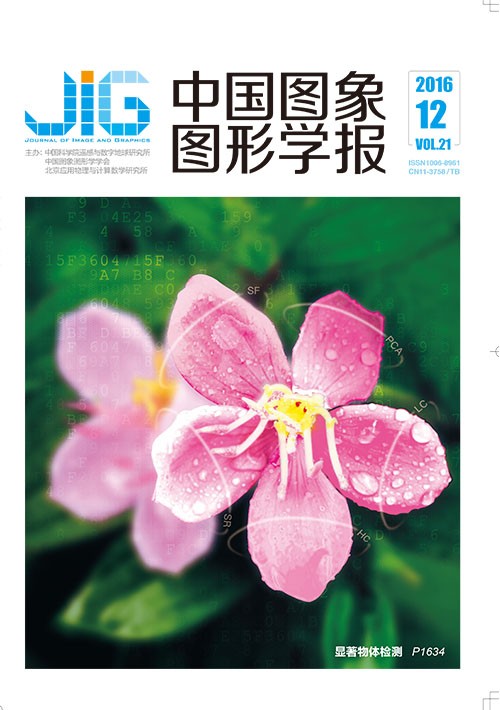
暗通道先验的大坝水下裂缝图像增强算法
马金祥1,2, 范新南1,3, 吴志祥2, 张学武3, 史朋飞3, 汪耕任3(1.河海大学计算机与信息学院, 南京 210098;2.常州工学院电气与光电工程学院, 常州 213032;3.河海大学物联网工程学院, 常州 213022) 摘 要
目的 大坝水下裂缝图像存在非均匀亮度、低信噪比、低对比度等复杂情况,导致裂缝特征提取极为困难,本文提出一种改进暗通道先验的大坝水下裂缝图像自适应增强算法。方法 首先对非均匀光照图像进行全局匀光处理和噪声抑制处理,在保护纹理信息的同时消除亮度分布不均的问题;其次改进暗通道先验理论,结合导向滤波方法,精确估算去噪恢复图像;然后对去噪恢复图像进行基于概率分布理论3σ原则的自适应分段线性增强;最后对增强图像从均值、方差、峰值信噪比、对比度和信息熵等方面进行整体定量评价。结果 选取了2幅典型的水下光照不均匀大坝裂缝图像作为研究对象,采用本文提出的方法进行图像增强处理。将本文算法的增强效果与直方图均衡化、同态滤波、多尺度视网膜增强算法(MSR)以及带色彩恢复的多尺度视网膜增强算法(MSRCR)的增强效果进行对比分析。为了测试本文方法的鲁棒性,对原图像增加椒盐噪声信号和高斯噪声信号,评估本文算法对包含确定分布噪声的抗干扰能力。本文方法相比以上其它方法,具有最好的增强效果,对2幅原始图像对应增强图像的峰值信噪比(PSNR)分别为42.77和41.49。结论 仿真实验结果表明,本文方法能有效抑制水下图像噪声干扰,增强大坝水下裂缝图像的清晰度。本文方法对不同光照条件下大坝水下裂缝图像增强有很强的自适应性,对水下裂缝图像增强处理有效可行。
关键词
Underwater dam crack image enhancement algorithm based on improved dark channel prior
Ma Jinxiang1,2, Fan Xinnan1,3, Wu Zhixiang2, Zhang Xuewu3, Shi Pengfei3, Wang Gengren3(1.College of Computer and Information, Hohai University, Nanjing 210098, China;2.School of Electric and Photo-electronic Engineering, Changzhou Institute of Technology, Changzhou 213032, China;3.College of Internet of Things Engineering, Hohai University, Changzhou 213022, China) Abstract
Objective Extracting clear crack images from an underwater dam image is the fundamental step in digital imaging application. These images are the crucial prerequisite for good understanding of real underwater dam scenes. However, complex underwater environmental conditions, such as uneven illumination distribution, low signal-to-noise ratio, and low contrast, make the task of extracting clear crack images more challenging than in other conditions. We propose a self-adaptive image enhancement algorithm based on improved dark channel prior for underwater dam crack images. Method Global illumination balance and noise suppression processes were conducted to deal with the uneven illumination problem while maintaining the original image textures. The underwater dam images with different illumination conditions correspond to different brightness balance layers. Accurate estimation of denoising image was processed on the basis of improved dark channel prior and guided filtering. The proposed algorithm improved the original dark channel prior method in terms of optical transmittance, which is determined by the absolute difference value of the global atmospheric light and the dark channel values. If the absolute difference value is greater than the threshold, then the image pixels are in the dark zone. Otherwise, the image pixels are in the bright zone. The optical transmittance formula varies according to the different illumination zones. A self-adaptive, parameter-calculating method of 3σ introduction principle was used to compute the image tensile stretch points and enhance the image. A series of evaluation parameters, such as mean, variance, peak signal-to-noise ratio (PSNR), contrast, and information entropy, were proposed to assess the image enhancement algorithms. Result The proposed algorithm is tested to enhance underwater dam crack images with different uneven illumination conditions. Two typical underwater dam crack images, namely, a medium-sized crack image and a small crack image, are selected as research objects. The enhancement effects of the proposed algorithm are compared with those of other enhancement algorithms such as histogram equalization, homomorphic filtering, multiscale retinex, and multiscale retinex with color restoration. To test the robustness of the proposed algorithm, salt-pepper noise and Gaussian noise are added to the original underwater dam crack images to evaluate the anti-interference ability of the proposed algorithm with specific distribution noise. The different sizes of salt-pepper noise and Gaussian noise are used in this experiment. The proposed algorithm has the best enhancement effects compared with the aforementioned enhancement algorithms. It has shown strong robustness against specific interferences such as salt-pepper noise and Gaussian noise. The PSNR levels of the proposed algorithm for the two original images are 42.77 and 41.49, which are higher than those of other image enhancement algorithms. Conclusion The simulation experiment results show that the proposed algorithm can effectively suppress noise interference and enhance image quality of the underwater dam crack image. The proposed algorithm has preferable adaptive performance for underwater dam crack image with different brightness conditions. This improved algorithm is feasible and efficient for underwater dam crack image enhancement.
Keywords
|



 中国图象图形学报 │ 京ICP备05080539号-4 │ 本系统由
中国图象图形学报 │ 京ICP备05080539号-4 │ 本系统由